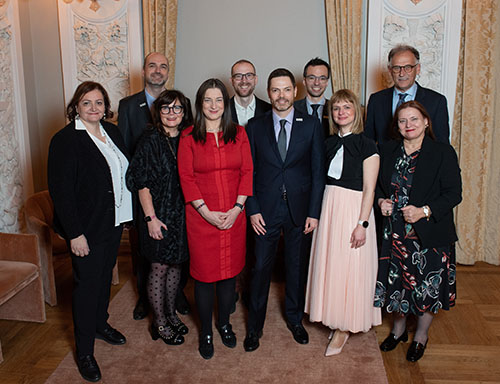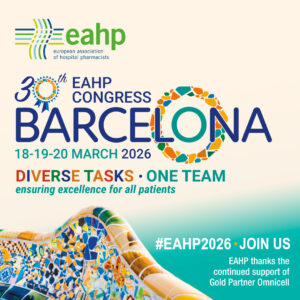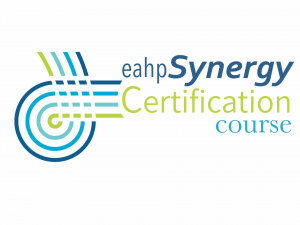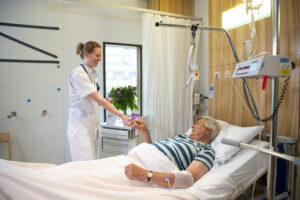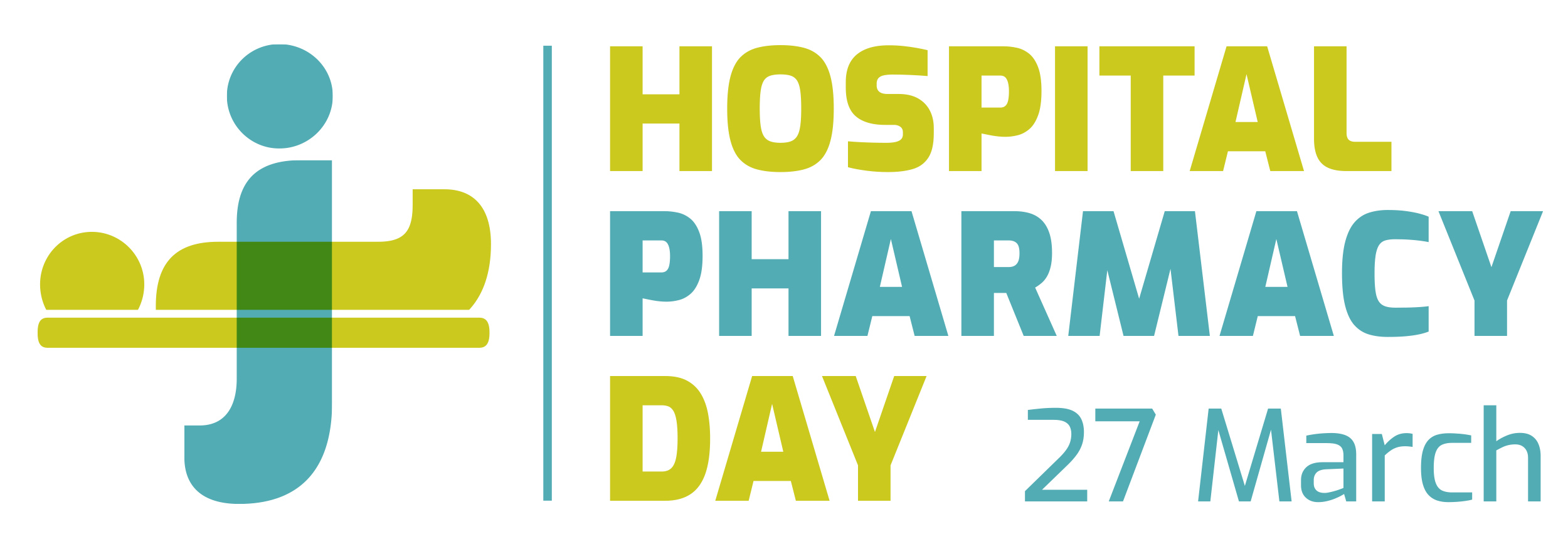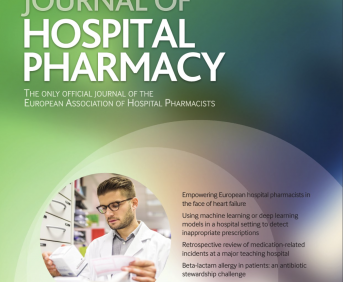SHARED PHARMACEUTICAL CARE PROGRAMME AGAINST COVID-19
Pdf

European Statement
Clinical Pharmacy Services
Author(s)
OLIVIA FERRÁNDEZ, CRISTINA RODRIGUEZ, NURIA CARBALLO, ZARA CORINNE, MARTA DE ANTONIO, MIQUEL OJEDA, RITA PUIG, JORDI DE DALMASES, JORDI CASAS, SANTIAGO GRAU
Why was it done?
It was established as a primary strategy against COVID-19 and to demonstrate the benefits of shared care of the patient, by hospital and community pharmacists, as regards to the improvement in their health status.
What was done?
In March 14th 2020, the Spanish Government declared the state of alarm which restricted citizens’ mobility due to the SARS-CoV-2 coronavirus pandemic. The Catalan Health Service (CatSalut), which provides health support to an autonomous community of 7.5 million people, issued a series of strategies to protect vulnerable patients from commuting to the hospital to collect their Outpatient Hospital Medicines (OHM).
One of these strategies established a shared pharmaceutical care program involving both hospital and community pharmacists. Thus patients collect their OHM at their local community pharmacy and avoid commuting to the hospital.
How was it done?
An official standard operating procedure reflecting this strategy was drawn up by CatSalut, Barcelona Pharmacists Association (COFB) and Hospital del Mar de Barcelona (HMar).
This project was initiated in March 23rd 2020 and it has been offered to all publicly funded hospitals in Catalonia.
A safe cloud-based web application, designed between COFB and HMar, was available to monitor all the medicines delivered using this circuit. Patients are included in this platform and are notified when their OHM has been sent to the community pharmacy selected by them. The computer application also includes a communication channel between community and hospital pharmacists to assess any medication-related incidence detected, as well as a telepharmacy service for patients.
What has been achieved?
In October 9th 2020, 3,293 patients, from 22(34.9%) hospitals in Catalonia, have been included to this system. The number of participating community pharmacies is 2,851(88.6%). A total of 8,806 treatments were delivered to the patients by community pharmacists. 10.2% of treatments are delivered through community pharmacies sharing the same postal code of the Hospital; 41.6% are delivered in the same municipality; 35.9%, in the same province and 12.3% are delivered through community pharmacies which are in a different province.
What next?
Establishing optimal communication channels between both professionals results in a better understanding of patients’ pharmacotherapeutic treatment and being able to act efficiently in those cases that are necessary.
Integration of clinical trials management into a safe and fully-automated onco-haematology workflow
Pdf

European Statement
Production and Compounding
Author(s)
FRANCESCA VAGNONI, ANDREA MARINOZZI, SABRINA GUGLIELMI, CHIARA CAPONE, FRANCESCA MURA, ADRIANA POMPILIO, SIMONE LEONI
Why was it done?
The management of CT requires thorough documentary evidence and well-organized reporting system in compliance with the Good Clinical Practice. Since 2009, the entire onco-haematology workflow is fully-controlled by information technology devices and robotic systems to prevent medication errors and guarantee data integrity. The implementation of APOTECAtrial was aimed to extend the same level of control to CTs.
What was done?
In 2018, a clinical trial (CT) managing system (APOTECAtrial) was integrated into the existing fully-automated workflow of the chemotherapy production unit. APOTECAtrial was developed to enable real-time visualization of CT-related data and trace the processing of investigational (IMP) and non-investigational (NIMP) medical products, such as delivery, assignment, preparation, return, and disposal.
How was it done?
A team of hospital pharmacists, physicians, clinical data managers, and IT specialists analysed the CT workflow and defined the system specifications. Data related to IMP/NIMPs (both for parenteral and oral administration), patients enrolled, and investigator/sponsor affiliations were entered into APOTECAtrial and sorted by CT. The onco-haematology unit’s electronic prescribing system was bidirectionally interfaced with APOTECAtrial. Aseptic preparation of patient-specific injectable therapies was implemented in the supporting device for manual preparation that checks dosage accuracy and identity by photographic and barcode recognition.
What has been achieved?
Since 2018, the overall number of CTs managed was 95. In total, 81 IMPs/NIMPs and 135 patients were entered into the system, while 2740 injectable therapies were prepared, 690 oral medications and 60 pre-filled syringes delivered. The following major objectives were achieved: automated inventory accounting and stock management, reduced manual time-consuming activities (i.e. documentation, transcription), standardized reports in digital not-editable format, and full traceability. In addition, audit trail tool tracks all user edits and changes performed at any stages of the CT management by electronically recording user’s name, date, and time. APOTECAtrial was evaluated by clinical research associates (CRA), clinical research organizations (CRO) and CT sponsors and approved for use in the daily clinical practice.
What next?
The project represents a good example of multidisciplinary collaboration focused on improving the quality of the processes in healthcare settings. The implementation of information technology and automation ensures improved data integrity, safety, and working efficiency, which are key determinants for managing CTs in hospital pharmacies.
Using in-house rapid quality control equipment to reveal morphine ampoule tampering – A case report
Pdf

European Statement
Patient Safety and Quality Assurance
Author(s)
Robert Baghdarsarian, Karin Hellström, Mattias Paulsson
Why was it done?
The health care providers at the Paediatric Emergency Ward discovered that when opening glass ampoules of morphine by snapping the top off, this did not result in the normal straight cut by the score. A close examination also revealed residual glue and the glass at the ampoule neck not being fully transparent. The sealed outer packaging also seemed manipulated for most of the morphine ampoules stored in the ward medication room. Simultaneously, staff discovered that one of the paediatric patients had not received the anticipated analgesic effect of the ordered morphine infusion.
What was done?
This case report describes how the compounding unit of Uppsala University Hospital (CU) was able to assist in analysing the contents of morphine glass ampoules and infusion solutions, in a case with suspected tampered containers
How was it done?
CU has invested in an easy-to-use spectrophotometer to check the concentration and identity of chemotherapy prepared in the clean rooms. The primary focus is to have an independent system to check preparations done by the chemotherapy robot e.g. in connection with software upgrades. This equipment was within hours adapted to be used for morphine analyses. The results clearly show that the infusion labelled 10 mg/mL was tampered with, containing only 0,4 mg/mL morphine. Samples were also sent to the Microbiological laboratory to check for risks for microbial exposure during infusion of tampered morphine.
What has been achieved?
CU was able to provide results of the contents of all ampoules, and the infusion solution administered to the patient, within a couple of hours and without any cost. The results showed that all ampoules had been emptied from its labelled contents and likely refilled with Sodium Chloride 9 mg/mL. The infusion solution given to patient was also likely prepared from a tampered ampoule. These results were crucial information in the conversation with parents about the incident, and the subsequent report to the police regarding the probable violence offence.
What next?
We recommend that all healthcare settings evaluate the possibility to collaborate closer with the hospital pharmacy, and in new ways.
Thanks to our CU being an integral part of the hospital with close interaction with wards, this rapid handling was possible to stage.
A multi-disciplinary teams’ collaborative approach to transition benralizumab dependent severe eosinophilic asthmatic patients to self-administration in response to the COVID-19 pandemic
Pdf

European Statement
Clinical Pharmacy Services
Author(s)
Grainne D’Ancona, Niall Stewart-Kelcher, Schaya Bains, Andrew Hearn, Joanne Kavangh, Cris Roxas, Linda Green, Linda Thomson, Marianna Fernandes, Brian Kent, Alexandra NanzerKelly, David Jackson, Jaideep Dhariwal
Why was it done?
The COVID-19 pandemic necessitated the rapid transition of benralizumab dependent SEA patients onto home administration to facilitate on-going therapy in a cohort of patients who were “shielding” under UK government guidance.
What was done?
246 severe eosinophilic asthmatic (SEA) patients treated with benralizumab; a biologic agent targeting the human interleukin-5 receptor (IL-5Rα), at a specialist NHS asthma clinic, were transferred to self-administration at home in response to the COVID-19 pandemic. Alongside this, patients continued to need to be newly initiated on benralizumab therapy in spite of the pandemic and innovative pathways were created to ensure rapid initiation of therapy and home administration.
How was it done?
A varied multi-disciplinary team including pharmacists, pharmacy technicians, specialist nurses, doctors, physios and phycologist conducted a variety of in-person and virtual (telephone and video) consultations to consent and train patients on self-administration in their own homes in a rapid transfer to home administration.
What has been achieved?
We have investigated this patient cohort for any unwarranted effects by comparing the last Asthma Control Questionnaire-6 (ACQ6) measured in clinic with that collected by telephone consultation 8-12 weeks after transition to home administration. 246 benralizumab patients were included in the analysis, of whom 49 (20%) were new. There was no significant difference in pre-biologic ACQ6, pre-homecare (baseline) ACQ6 or post-homecare ACQ6 between the new and established patient groups. Both cohorts exhibited a similar magnitude of improvement in their ACQ6 following the transition to home administration (-0.73 in the established group vs -0.73 in the new group, both P<0.0001). We have demonstrated that early transition to home administration in patients treated with benralizumab is not associated with worse clinical outcomes as assessed by ACQ6.
What next?
Evaluation of patient experience on the switch to self-administration is currently being carried out via patient surveys with this data due to be completed in early 2021. Further research is required to understand the potential influence of lockdown and/or telephone vs face-to-face ACQ reporting.
RESHAPING OF CLINICAL PRACTICE AND REORGANISATION OF CHEMOTHERAPEUTIC PROTOCOLS DURING COVID-19 PANDEMIC: THE INITIATIVE OF THE NATIONAL INSTITUTE OF TUMORS
Pdf

European Statement
Clinical Pharmacy Services
Author(s)
Giuliana Lo Cricchio, Margherita Galassi, Ernesto Ruffino, Claudia Tirone, Vito Ladisa
Why was it done?
In accordance with regional provisions and national guidelines, the initiative has had the dual objective of reducing hospital access, and potential infections, and ensuring therapeutic continuity for cancer patients.
What was done?
Some therapy protocols have been modified for the treatment of blood, gastrointestinal, lung, breast, head and neck tumors, in order to obtain equally effective patterns but with longer intervals between doses.
How was it done?
Patients have been stratified on the basis of the neoplasia location and biology, the general conditions and the treatments characteristics and they have been shifted to modified treatment regimes, even outside the indications temporarily authorized by regional decision: Nivolumab from 240 mg Q2W to 480 mg Q4W for Hodgkin lymphoma, non-small-cell lung-cancer, squamous cell carcinoma of the head and neck; from weekly Paclitaxel to Docetaxel Q3W for breast cancer; Pembrolizumab from 200 mg Q3W to 400 mg Q6W for lung cancer and melanoma; remodulation of protocols including fluoropyridines and platinum coordination compounds for gastroenteric tumors.
What has been achieved?
The schedule modification allowed a reshaping of agendas to reduce the frequency of day-hospital access and the risk of infection with Sars-Cov-2 for patients, carers and health professionals, in addition to reducing the costs of outpatient services. Treatment interruption rate, with possible consequent progression of disease, as reported by early Chinese data in the literature, has been reduced.
What next?
The extraordinary health emergency changed the clinical practice and aroused interest especially in oncology, where the evaluation of the relationship between benefits and risks associated with therapies has required greater attention because they are life-saving therapies that cause immunosuppression in patients for which the adverse course of viral infection is more frequent than that of the non-neoplastic population.
The possibility of using the modified therapy schemes has been limited only to the emergency period and has not yet resulted in an extension of the indications. The achievement of the therapeutic objective, together with the feedback that the new dosages have not led to a significant increase in adverse events compared to normal clinical practice, encourage us to hope that the indications can be extended in Italy, as has already happened in Canada and USA for the Nivolumab.
A multi-disciplinary teams’ collaborative approach to transition mepolizumab dependent severe eosinophilic asthmatic patients to self-administration in response to the COVID-19 pandemic
Pdf

European Statement
Clinical Pharmacy Services
Author(s)
Grainne D’Ancona, Niall Stewart-Kelcher, Schaya Bains, Andrew Hearn, Joanne Kavanagh, Cris Roxas, Linda Green, Louise Thomason, Marianna Fernandes, Brian Kent, Alexandra NanzerKelly, David Jackson, Jaideep Dhariwal
Why was it done?
The COVID-19 pandemic necessitated the rapid transition of the remaining 41 mepolizumab dependent SEA patients onto home administration to facilitate on-going therapy in a cohort of patients who were “shielding” under UK government guidance.
What was done?
87 severe eosinophilic asthmatic (SEA) patients treated with mepolizumab; a biologic agent targeting interleukin-5 (IL-5), at a specialist NHS asthma clinic, were transferred to self-administration at home compared to usual practice of administration in a hospital setting. 40 patient were transferred in late 2019 as a planned ‘pilot’ transition and 47 patients were transferred unplanned due to the COVID-19 pandemic. We investigated whether there was a change in asthma control following the transition to home administration and whether a differential response to treatment exists following transition to homecare before and after the onset of the COVID-19 pandemic.
How was it done?
A varied multi-disciplinary team including pharmacists, pharmacy technicians, specialist nurses, doctors, physios and phycologist conducted a variety of in-person and virtual (telephone and video) consultations to consent and train patients on self-administration in their own homes in a rapid transfer to home administration
What has been achieved?
Patients receiving mepolizumab at home were stratified according to those who had a planned transition prior to 1st Feb 2020 versus those who had an unplanned transition after this date necessitated by the COVID-19 pandemic. The last Asthma Control Questionnaire-6 (ACQ6) measured in clinic (“baseline”) was compared with that collected by telephone consultation 6-8 weeks after transition. Immediately prior to transition to homecare (baseline), the planned group had a lower mean ACQ6 than those in the unplanned group (1.19 vs 1.90, P=0.004). The ACQ6 on home administration decreased significantly in both groups (-0.47 in the planned group vs -0.56 in the unplanned group, both P<0.001). The ACQ6 for the planned cohort during homecare was significantly lower than that for the unplanned group (0.72 vs 1.34, P=0.012).
What next?
Evaluation of patient experience on the switch to home administration is currently being carried out via patient surveys with this to be completed in early 2021. Further research is required to understand the potential influence of lockdown and/or telephone vs face-to-face ACQ reporting.
DETECTION OF PHARMACOKINETIC/PHARMACODYNAMIC DRUG INTERACTIONS OR PATHOPHYSIOLOGICAL CONTRAINDICATIONS WITH INJECTABLE CHEMOTHERAPIES: IMPLEMENTATION OF THE SOFTWARE PHARMACLASS® IN ONCOLOGY
Pdf

European Statement
Clinical Pharmacy Services
Author(s)
Pauline Barreau, Joséphine Courouble, Pierre Pilven, David Vandecapelle, Thibault Stala, Geoffrey Strobbe, Guillaume Marliot, Frédéric Feutry
Why was it done?
Two prescription assistance software are using in the hospital: DXCare®, for global drug management, and Chimio®, specific to the prescription and preparation of injectable chemotherapies. Clinical pharmacists (DXCare®) and pharmacists in charge of preparation (Chimio®) carry out the pharmaceutical analysis independently and they may not detect potential pharmacokinetics/pharmacodynamics drugs interactions or pathophysiological contraindications, slowing down the pharmaceutical analysis. Pharmaclass® can improve that by crossing all data flows between DXCare® and Chimio® and alerting the pharmacist. The objective were to select and code priority alerts and evaluate the detectability of drugs interactions and pathophysiological contraindications by the software Pharmaclass®.
What was done?
Pharmaclass® is a software based on rules created by the pharmacist, from pharmaceutical algorithms. This rules engine crosses in real time all data flows of several software and sends alerts that must be analyzed by a pharmacist. It was applied in oncology for injectable chemotherapies.
How was it done?
An interface was set up between DXCare®/Chimio® and Pharmaclass® to allow the creation of requests. An analysis of drug consumptions and drugs at risk of interactions helped to select seven molecules (Methotrexate, Bevacizumab, Fluorouracil, Ifosfamide, Irinotecan, Cisplatin, Pemetrexed). A study of the summaries of the product characteristics and the drug interaction thesaurus and a bibliography was conducted and the rules were coded. These were checked by creating test patients with false prescriptions.
What has been achieved?
Eleven rules were created and, after some tests and coding readjustments, all was detected. Nine rules are about drugs interactions: three contraindications (Methotrexate/Trimethoprim, Methotrexate/Acetylsalicylic acid, Bevacizumab/Naloxegol), three associations not recommended (Methotrexate/Amoxicillin, Methotrexate/Ciprofloxacin, Fluorouracil/Antivitamin K), one precaution of use (Ifosfamide/Aprepitant) and two other rules concern enzymatic induction and inhibition of the metabolism of Irinotecan. The last two rules link the glomerular filtration rate with Cisplatin and Pemetrexed.
What next?
Following these creations, Pharmaclass® has allowed to detect drug interactions and pathophysiological contraindications that were not previously detectable. Thereafter, objective will be to establish an organization for the management of alerts and evaluate the number and the relevance of these alerts. New rules will be created for all injectable chemotherapies used in the hospital. Other center of Unicancer will be able to use these rules.
USE OF LINKED DATA SOURCES IN DYNAMIC DASHBOARDS TO VISUALISE HOSPITAL PRACTICE DIFFERENCES IN MEDICATION USE AND OUTCOMES
Pdf

European Statement
Patient Safety and Quality Assurance
Author(s)
Rawa Ismail, Jesper van Breeschoten, Michel Wouters, Anthonius de Boer, Alfonsus van den Eertwegh, Maaike van Dartel, Caspar van Loosen, Doranne Hilarius
Why was it done?
Most drugs obtain approval based on limited numbers of highly selected patients and mostly surrogate outcomes. Little is known on hospital variation on the use of new treatments in daily clinical practice. Benchmark information can be used to limit between hospital variation and provides real world evidence on the value of these treatments.
What was done?
In the Dutch Institute for Clinical Auditing (DICA) medicines project, administrative data on the use of expensive drugs from hospital pharmacies were linked to clinical data from national quality registries and hospital declaration data. Data were visualised in six dynamic dashboards (lung cancer, breast cancer, rheumatic disorders, colorectal cancers, gynaecological cancers and metastatic melanoma), leading to insight into expensive drugs use and clinical outcomes in real-world practice.
How was it done?
The three data sources were linked using patient-specific data and provide real-world insights in anti-cancer drug use and outcomes. After linkage, data were validated by individual sessions with hospital pharmacists and medical specialists.
What has been achieved?
Hospital pharmacists and medical specialists gained insight into expensive drugs use and treatment patterns in patient groups, compared to other hospitals. The dashboards also contain information on outcomes such as toxicity, emergency admissions, time-to-next treatment and users receive signals when their use of expensive medicines deviates from the benchmark. An example of the information provided by the dashboards was the number of stage IV non-small cell lung cancer patients treated with only one or two gifts of pembrolizumab. All hospitals received a report on this subpopulation to improve their treatment approach. Other findings were differences in the adjuvant treatment of stage III colon carcinoma patients and the treatment duration of trastuzumab/pertuzumab as adjuvant treatment in breast cancer patients.
What next?
The DICA medicines project is an example of good practice as it reuses available data sources without any additional registration burden. In the future, the dashboards will be extended with survival data and PROMs data. The focus of the program in the next year will be to include all hospitals in the Netherlands and to extend the dashboards with more features.
CLINICAL PHARMACOKINETICS OF ANTI-TNF THERAPY: OUR FIRST EXPERIENCE IN INFLAMMATORY BOWEL DISEASE
Pdf

European Statement
Clinical Pharmacy Services
Author(s)
María Mar Alañón Pardo, Alejandro Marcos de La Torre, Beatriz Proy Vega, Adrián Pérez Facila, María Luisa Moreno Perulero, Clara Notario Dongil
Why was it done?
Numerous publications have demonstrated a correlation between serum concentrations (Cs) of anti-TNF drugs and the therapeutic response and a wide interindividual variability in pharmacokinetics among patients with IBD. TDM permits dosage individualization and optimization of anti-TNF therapy.
What was done?
Pharmacokinetic monitoring (TDM) of anti-TNF therapies (infliximab/adalimumab) in inflammatory bowel disease (IBD) was implemented in our hospital by a multidisciplinary team of pharmacists, gastroenterologists and clinical analysts.
How was it done?
A computer platform was developed within the hospital electronic records system to manage consultations of gastroenterologists with the Clinical Pharmacokinetics Unit (CPU) of the Pharmacy Department. Variables in this electronic interconsultation system were: “anti-TNF drug”, “concomitant immunomodulator (IMM)”, “diagnosis”, “reason for consultation”, “date of last dose”, “date of extraction”, “weight/height”, and “observations”. Laboratory tests ordered from the Department of Clinical Analysis on the electronic request form included blood count, Cs of infliximab/adalimumab, albumin, C-reactive protein and faecal calprotectin. Quantum Blue® lateral flow immunoassay was used to quantify Cs of the anti-TNF drugs; when undetectable, the presence of anti-drug antibodies (ADAs) was investigated.
The CPU developed pharmacotherapeutic recommendations based on therapeutic algorithms, pharmacokinetic/pharmacodynamic principles and population models implemented using MW-Pharm++® software, which incorporates the principle of Bayesian estimation. For a correct interpretation of the Cs observed, adherence to anti-TNF ± IMM regimens was evaluated using electronic dispensing records and the self-administered Morisky-Green questionnaire.
What has been achieved?
Since its implementation (January 2019 – August 2020), the CPU has responded to 269 consultations on 121 patients treated with infliximab (46.3%) or adalimumab (53.7%): 70.2% were prescribed with IMM (89.4% with thiopurines); 93.4% adhered to the anti-TNF regimen and 82.4% to the IMM. Baseline anti-TNF Cs were subtherapeutic in 37.2% of patients, therapeutic in 35.5% and supratherapeutic in 27.3%. ADAs were positive in 28.6% of patients with undetectable anti-TNF Cs (n=28). A large proportion (84.8%) of consultations were related to proactive monitoring (to optimise treatment) and the remainder were reactive (after treatment failure). A very high percentage (89.9%) of the gastroenterology specialists accepted recommendations.
What next?
Extend TDM to other biological therapies and immune-mediated diseases.
THE EXPERIENCES OF A UNIVERSITY HOSPITAL MEDICATION PREPARATION UNIT IN COVID-19 PANDEMIC
Pdf

European Statement
Clinical Pharmacy Services
Author(s)
Sinem Şeker Şimşek
Why was it done?
In terms of medication and patient safety, to establish a safe non-cytotoxic medication preparation process, to ensure continuity of well-educated and motivated pharmacy staff are the key elements of pharmacy-based medication preparation units. This work aimed to share our experiences about how to be challenged with the risk in the drug preparation process during the pandemic as a university hospital pharmacy centered non-cytotoxic medication preparation unit.
What was done?
We have taken general precautions recommend by the World Health Organization. However, the protocol we have used to prepare Lopinavir/Ritonavir, Preparation of Hydroxychloroquine sulfate, Favipiravir and Hydroxychloroquine sulfate with Simple Syrup, Preparation of intravenous drugs (Tocilizumab)
How was it done?
The preparation of solid oral dosages, which should be administered to intubated Covid-19 patients through a nasogastric tube, was prepared by the ready to administration team of our pharmacy.
There is no evidence-based data on the bioavailability of these enteric-coated tablets after being crushed and administered to these vulnerable patients. The biggest challenge was lack of the reliable medication information sources. Before starting the Covid-19 medications preparation process, possible risks that could arise if crushed administration of these drugs were evaluated with a multidisciplinary team.
What has been achieved?
We suspended the Lopinavir/Ritonavir with dextrose during the preparation phase. We preferred the lavage syringe for intravenous administration risk elimination through ensuring patient and drug safety by preventing the risk of intravenous administration of the diluted suspended drug we have prepared. However, when we used a 3-way infusion manifold the strain during pushing and easy disconnection of the joints thus the risk of dose loss were the disadvantages.
What next?
The two pillars of dealing with the COVID-19 epidemic, which has affected the whole globally, are the proper preparation of the necessary medicines for treatment and the treatment itself. Drugs were prepared in line with the search for “a practical solution immediately” and the directives of the Ministry of Health and successfully administered to the patients. Our study is noteworthy as it shows that drugs can be prepared not only by the default ways but also by the different methods
